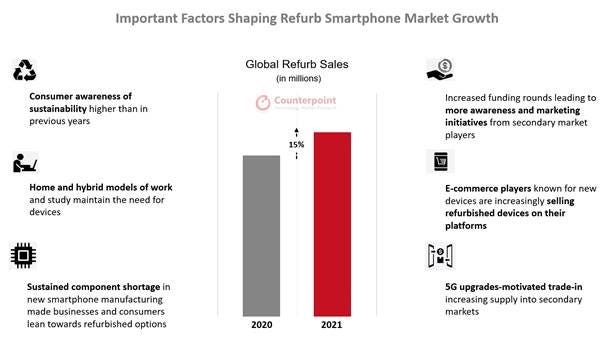Refurbished smartphones are getting more popular - Counterpoint
The global refurbished smartphone market grew by 15% in 2021, according to research from analyst firm Counterpoint.
April 20, 2022

The global refurbished smartphone market grew by 15% in 2021, according to research from analyst firm Counterpoint.
The refurbished or ‘secondary’ smartphone market experienced solid growth last year due to a rising interest in sustainability, awareness of the sub-market, certified pre-owned alternatives, and an increase in quality checks and warranty options, according to Counterpoint Research’s Global Refurb Smartphone Tracker.
Latin America and India clocked the highest growth rates, at 29% and 25% respectively. Apparently growing momentum for something called the ‘Right to Repair movement’ has also led to more refurbishment players in the European, US and Japanese markets.
“Refurbished smartphones are a part of overall pre-owned devices which re-enter the system through various routes,” said Senior Analyst Glen Cardoza. “Trade-ins are the fastest growing source for such pre-owned smartphones, the volume of which grew more than 10% globally in 2021. We are seeing a YoY increase in volumes among refurb players in developing markets like China, India, Latin America, Southeast Asia and Africa. These markets will grow more as they have many unorganized businesses and a large rural demographic yet to be captured. ASPs (average selling prices) of refurbished smartphones increased marginally as 4G devices still retained value.”
Research Director Jeff Fieldhack added: “The US and EU secondary markets bounced back in 2021. In the US, new Apple and Samsung flagship sales increased, which in turn increased the volumes of collected devices at carriers and other collection channels. On the consumption side, amid increasing insurance attach rates, the use of CPO (certified pre-owned) devices as insurance replacements increased during 2021. The B2B consumption of used devices also increased. In the EU, government initiatives are helping secondary market sales. Carriers are also making efforts to use more secondary market devices with e-waste reduction goals. Finally, EU marketplaces and collection companies – Back Market and EcoATM being examples – are growing their presence.”
Sustainability may well play a large factor into a decision to pick up a refurbished smartphone, and you don’t have to be an activist for that sort of thing to think its generally a good idea to reused things where possible. However another contributing factor may well be the increasing cost of flagship phones particularly from Apple, and the fact that a general slow down in hardware innovation means there isn’t as much to tell phone generations apart as there once was.

Get the latest news straight to your inbox. Register for the Telecoms.com newsletter here.
About the Author
You May Also Like


.png?width=300&auto=webp&quality=80&disable=upscale)







.png?width=300&auto=webp&quality=80&disable=upscale)


_1.jpg?width=300&auto=webp&quality=80&disable=upscale)